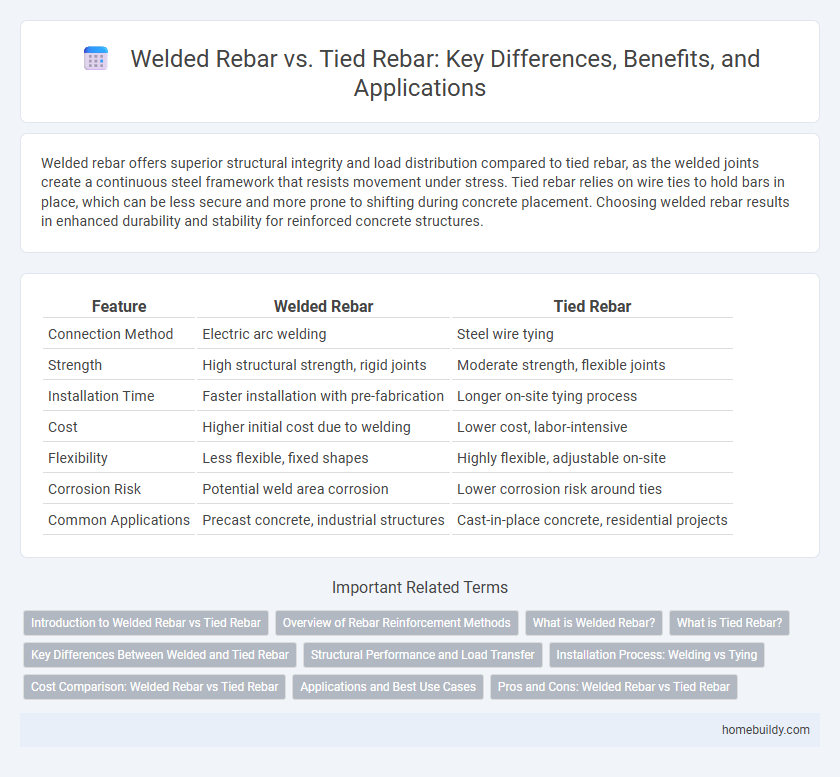Welded rebar offers superior structural integrity and load distribution compared to tied rebar, as the welded joints create a continuous steel framework that resists movement under stress. Tied rebar relies on wire ties to hold bars in place, which can be less secure and more prone to shifting during concrete placement. Choosing welded rebar results in enhanced durability and stability for reinforced concrete structures.
Table of Comparison
| Feature | Welded Rebar | Tied Rebar |
|---|---|---|
| Connection Method | Electric arc welding | Steel wire tying |
| Strength | High structural strength, rigid joints | Moderate strength, flexible joints |
| Installation Time | Faster installation with pre-fabrication | Longer on-site tying process |
| Cost | Higher initial cost due to welding | Lower cost, labor-intensive |
| Flexibility | Less flexible, fixed shapes | Highly flexible, adjustable on-site |
| Corrosion Risk | Potential weld area corrosion | Lower corrosion risk around ties |
| Common Applications | Precast concrete, industrial structures | Cast-in-place concrete, residential projects |
Introduction to Welded Rebar vs Tied Rebar
Welded rebar features steel bars fused at intersections through electric resistance welding, providing a rigid, uniform grid that enhances structural integrity and load distribution. Tied rebar consists of individual steel bars manually secured with wire ties, allowing for greater flexibility and adjustment during installation but potentially less stability under dynamic loads. Understanding the distinctions between welded and tied rebar is crucial for selecting the appropriate reinforcement method to meet specific construction requirements and project durability.
Overview of Rebar Reinforcement Methods
Welded rebar utilizes grid-like steel mesh where bars are fusion-welded at intersections, providing uniform load distribution and enhanced structural integrity ideal for slabs and walls. Tied rebar involves fastening individual bars together with wire ties, offering greater flexibility for complex shapes and adjustments on-site, commonly used in beams and columns. Both methods ensure concrete reinforcement, with welded rebar excelling in rigidity while tied rebar provides customizable placement efficiency.
What is Welded Rebar?
Welded rebar consists of steel bars joined together at intersections through electric resistance welding, creating rigid reinforcement grids commonly used in concrete structures. This method provides enhanced structural integrity and uniform load distribution compared to tied rebar, which relies on wire ties to hold bars in place without permanent fusion. Welded rebar is preferred in applications needing precise alignment and higher strength, such as slabs, walls, and precast concrete elements.
What is Tied Rebar?
Tied rebar refers to steel reinforcing bars held together at intersections using steel wire ties or rebar ties to maintain proper alignment and spacing within concrete structures. This method allows for flexibility in placement and adjustment during construction, ensuring structural integrity by preventing movement before and during concrete pouring. Tied rebar is commonly used in projects where customization and on-site modifications are necessary, contrasting with welded rebar, which involves fixed, factory-made connections.
Key Differences Between Welded and Tied Rebar
Welded rebar consists of steel bars joined by electric welding, providing a rigid and dimensionally stable reinforcement grid that enhances structural integrity in concrete applications. Tied rebar employs steel wire ties to fasten individual bars together, allowing flexibility and ease of adjustment on-site but potentially reducing bonding strength compared to welded connections. The primary differences lie in installation speed, load distribution efficiency, and the overall durability of the reinforcement framework in construction projects.
Structural Performance and Load Transfer
Welded rebar provides enhanced structural performance through rigid connections that improve load transfer efficiency and reduce deflection under stress. Tied rebar relies on mechanical binding, which can result in minor slippage and less efficient load distribution during dynamic or seismic events. The stronger bond in welded rebar assemblies increases overall stability and resistance to deformation compared to tied rebar systems.
Installation Process: Welding vs Tying
Welded rebar installation involves fusing steel bars together using specialized welding equipment, creating rigid, strong joints that reduce movement and enhance structural integrity. Tied rebar installation requires manually securing bars with wire ties at intersections, offering greater flexibility but requiring more labor and time on-site. Welding generally demands skilled labor and safety precautions while tying allows quicker adjustments during placement without specialized tools.
Cost Comparison: Welded Rebar vs Tied Rebar
Welded rebar generally incurs higher initial costs due to specialized equipment and labor but offers long-term savings by reducing installation time and enhancing structural integrity. Tied rebar is less expensive upfront, relying on manual tying with wire, but may result in higher labor costs and longer project durations. Evaluating overall project budgets reveals welded rebar as a cost-effective option for large-scale or repetitive construction, whereas tied rebar suits smaller projects with limited budgets.
Applications and Best Use Cases
Welded rebar is ideal for projects requiring high structural integrity and precise alignment, such as bridges, high-rise buildings, and heavy industrial foundations, offering enhanced load distribution and resistance to shear forces. Tied rebar is best suited for residential and light commercial construction where flexibility, ease of adjustment, and cost-effectiveness are priorities, allowing for quicker installation in less demanding structural applications. Choosing between welded and tied rebar depends on factors like load requirements, site conditions, and project scale to maximize performance and durability.
Pros and Cons: Welded Rebar vs Tied Rebar
Welded rebar offers superior structural integrity and faster installation due to factory precision and reduced labor on-site, enhancing load-bearing capacity in reinforced concrete. Tied rebar provides flexibility in design adjustments and lower upfront costs but requires more labor and can result in less uniform spacing, potentially weakening overall concrete strength. Choosing between welded and tied rebar depends on project scale, complexity, and budget constraints, as welded rebar suits large projects demanding consistency while tied rebar benefits smaller, adaptable constructions.
Welded Rebar vs Tied Rebar Infographic

 homebuildy.com
homebuildy.com